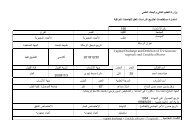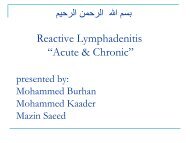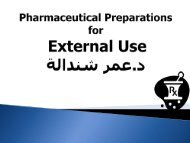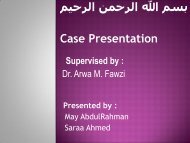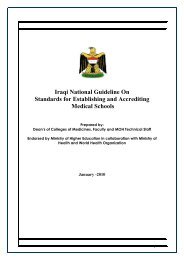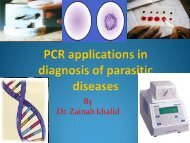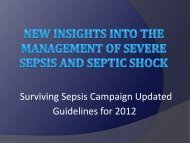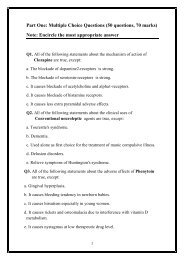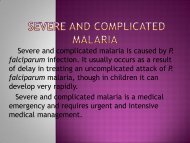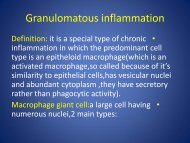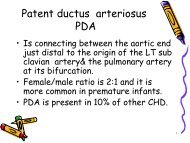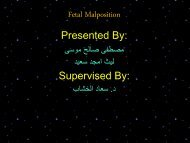Volume 35 June 2009 Number 1 - University of Mosul
Volume 35 June 2009 Number 1 - University of Mosul
Volume 35 June 2009 Number 1 - University of Mosul
Create successful ePaper yourself
Turn your PDF publications into a flip-book with our unique Google optimized e-Paper software.
Annals <strong>of</strong> the College <strong>of</strong> Medicine Vol. <strong>35</strong> No. 1, <strong>2009</strong><br />
bodies and instrumentation were the<br />
commonest causes <strong>of</strong> the perforation in the<br />
age group (≤10 years), 6 patients (75%)<br />
(Figure 2).<br />
The commonest site <strong>of</strong> traumatic perforation<br />
<strong>of</strong> tympanic membrane was posterior<br />
perforation which were 45 cases (54%), then<br />
central (kidney shape) were 20 cases (24%),<br />
then anterior perforation were 12 cases (14%),<br />
then subtotal perforation were 7 cases (8%)<br />
(six due to blast injury, and one due to foreign<br />
body button battery (Table 1).<br />
From 84 perforated tympanic membranes, in<br />
69 cases (82%) the spontaneous healing<br />
occurred, 8 cases (9.5%) got dry perforation<br />
with normal middle ear mucosa, and 7 cases<br />
(8.5%) having active chronic suppurative otitis<br />
media. (Table 2).<br />
Spontaneous healing <strong>of</strong> perforation due to<br />
fracture <strong>of</strong> temporal bone was (100%), then<br />
foreign body and instrumentation, ear<br />
syringing, and hand slap were (89%) (88%)<br />
(88%) respectively. Perforations due to ear<br />
suction was (80%), blast injury was (75%)<br />
(Table 2).<br />
Spontaneous healing <strong>of</strong> posterior and<br />
anterior perforation was about equal (92%),<br />
(91%) respectively; for central (kidney shape)<br />
perforation was (85%), but none <strong>of</strong> seven<br />
cases with subtotal perforation got<br />
spontaneous healing, four cases with<br />
continuous otorrhea ( chronic suppurative otitis<br />
media), and three cases ended with dry<br />
perforation during the follow up period (Table<br />
3).<br />
The duration <strong>of</strong> complete spontaneous<br />
healing was within 2 weeks in eleven cases<br />
(16%), 27 cases (39%) healed within 4 weeks,<br />
18 cases (26%) healed within 6 weeks, and 13<br />
cases (19%) healed within more than 6 weeks,<br />
so (81%) healed spontaneously within the first<br />
six weeks (Table 4).<br />
Table (1): The site and size <strong>of</strong> traumatic perforation<br />
Site <strong>of</strong> the<br />
perforation.*<br />
Total<br />
Blast<br />
injuries<br />
Hand slap<br />
Foreign<br />
body<br />
Ear<br />
syringing<br />
Ear<br />
suction<br />
Fracture<br />
temporal<br />
bone<br />
Posterior 45 (54%) 19 (42%) 16 (36%) 3 (6.6%) 3 (6.6%) 2 (4.4%) 2 (4.4%)<br />
Anterior 12 (14%) 5 (42%) 4 (33%) 1 (8%) 0 2 (17%) 0<br />
Central (kidney<br />
shape)<br />
20 (24%) 6 (30%) 4 (20%) 4 (20%) 5 (25%) 1(5%) 0<br />
Sub total 7 (8%) 6 (86%) 0 1 (14%) 0 0 0<br />
Total 84 (100%) 36 (43%) 24 (28.5%) 9 (11%) 8 (9.5%) 5 (6%) 2 (2%)<br />
*No attic or marginal perforations were reported.<br />
Table (2): Sequelae <strong>of</strong> the traumatic perforation <strong>of</strong> the tympanic membrane<br />
Type <strong>of</strong> trauma No. Perforated T.M Healed Dry perforation. CSOM (active)<br />
Blast injury. 36 27 (75%) 6 (17%) 3 (8%)<br />
Hand slap 24 21 (88%) 2 (8%) 1 (4%)<br />
Foreign body. 9 8 (89%) 0 1 (11%)<br />
Ear syringing. 8 7 (88%) 0 1 (12%)<br />
Ear suction. 5 4 (80%) 0 1 (20%)<br />
Fracture temporal bone 2 2 (100%) 0 0<br />
Total. 84* 69 (82%) 8 (9.5%) 7 (8.5%)<br />
* 4 patients with bilateral perforation, 2 blast injury, and 2 open hand slap.<br />
© <strong>2009</strong> <strong>Mosul</strong> College <strong>of</strong> Medicine 28




